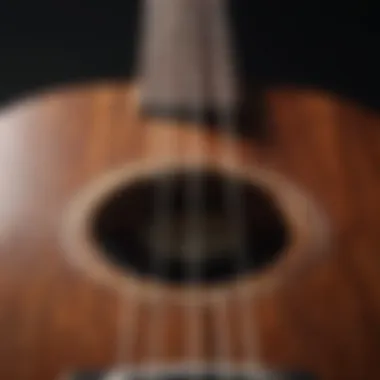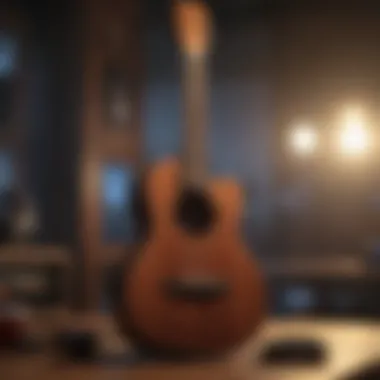Comprehensive Guide to Stringing Your Ukulele


Intro
Stringing a ukulele is a fundamental skill for players of all levels, yet it can be daunting for newcomers. This task not only influences the sound quality of the instrument but also its longevity. The process involves selecting suitable strings, using the right tools, and following proper techniques for installation. In this guide, we aim to simplify this vital task and provide a structured approach to stringing a ukulele effectively.
The Importance of Stringing a Ukulele
Understanding how to string a ukulele enhances the player's experience. Fresh strings contribute to better sound, improved playability, and an overall more enjoyable session. As strings wear out, they can lose their tonal quality, making regular replacement essential. Knowing how often to change them and having the skills to do so empowers musicians.
Types of Ukulele Strings
Choosing the right strings involves understanding the various options available. Here are some common types:
- Nylon Strings: These are the most popular for ukuleles. They offer a warm sound and are easy on the fingers.
- Fluorocarbon Strings: These provide a brighter tone and stronger projection. They are less affected by changes in humidity compared to nylon.
- Gut Strings: Although rarely used today, gut strings deliver a unique sound preferred by some traditionalists.
Fresh strings can significantly impact both the sound quality and overall playing experience.
Necessary Tools for Stringing
Before starting, gather the required tools to ensure a smooth process:
- String winder: Helps speed up the stringing process.
- Wire cutters: Needed for trimming excess string.
- Tuner: Essential for achieving the correct pitch post-stringing.
- Capo: Useful for various tuning configurations.
Step-by-Step Instructions
Here’s a concise breakdown of how to string your ukulele effectively:
- Remove the Old Strings: Loosen and cut the existing strings.
- Clean the Frets and Body: Take a moment to wipe down the ukulele, clearing any grime.
- Attach the New Strings: Starting from the bridge, thread the new string through the corresponding hole.
- Secure the String: Bring the string up to the tuner peg, ensuring it is properly aligned.
- Wind the Strings: Use the string winder to make several twists around the peg, ensuring good tension.
- Tune the Ukulele: Use the tuner to get each string to the correct pitch.
- Trim Excess String: Cut the leftover string for a clean finish.
Post-Stringing Care
Once you’ve strung the ukulele, it’s critical to take care of the instrument:
- Regularly check tuning and make adjustments as needed.
- Clean the strings after each use to prolong their life.
- Store the ukulele in a controlled environment to prevent damage.
End
Stringing a ukulele is an essential skill that every player should master. With the right strings and tools, following the process can enhance the sound and playability of the instrument. Keeping the ukulele well-maintained and regularly restringing it will contribute to a better playing experience overall.
Prologue to Ukulele Stringing
Stringing a ukulele is a fundamental skill every player must master, yet many overlook its significance. Properly strung strings not only enhance the instrument's sound quality but also affect playability and longevity. This article provides a roadmap for understanding all aspects of ukulele stringing, ensuring both novice and experienced players can achieve the desired sound.
Importance of Proper Stringing
Proper stringing plays an essential role in achieving optimal performance from your ukulele. When strings are installed correctly, they provide a clear and in-tune sound, making the playing experience more enjoyable. Poorly strung strings may lead to unwanted buzzing, intonation issues, and even breakage. Therefore, knowing how to properly string a ukulele can save you time and frustration while extending the life of your instrument.
Additionally, regular maintenance of strings contributes to sound quality. Fresh strings can enhance brightness and clarity, helping musicians express their artistic vision more effectively. This means that proper stringing isn't just a necessity; it is an avenue for creative expression.
Overview of Ukulele Types
Understanding the various types of ukuleles is crucial before deciding on stringing methods. Each type of ukulele—soprano, concert, tenor, and baritone—comes with its own unique tonal qualities. Here is a brief overview:


- Soprano Ukulele: Considered the standard ukulele size, it offers a bright and cheerful sound, commonly used in traditional Hawaiian music.
- Concert Ukulele: Slightly larger than the soprano, the concert ukulele produces a richer tone, making it versatile for various music genres.
- Tenor Ukulele: This size produces more volume and deeper sound, making it popular among performers.
- Baritone Ukulele: The largest of the family, the baritone has a deeper, guitar-like tone and is tuned differently from the other types.
Understanding these types helps musicians select appropriate strings and adjust stringing techniques accordingly. Proper stringing techniques contribute to enhancing each type's unique sound and playing characteristics.
Understanding Ukulele Strings
Understanding ukulele strings is fundamental for players who desire optimal sound quality and longevity of their instrument. The types of strings you choose can greatly influence the playability and tone of your ukulele. Furthermore, recognizing the material and characteristics of different strings lays the foundation for effective stringing and maintenance practices.
Types of Ukulele Strings
Nylon Strings
Nylon strings are the most common type used for ukuleles, particularly on soprano and concert models. Their flexibility makes them conducive to ease of playing, which is especially beneficial for beginners. A key characteristic of nylon strings is their warm, mellow tone that resonates well with the ukulele's overall sound. This quality contributes to their popularity among players of all skill levels.
One unique feature of nylon strings is their ability to withstand various climates, making them versatile for players in different environments. The advantages of nylon strings include their affordability and comfort during play. However, they are less durable than other types, which may necessitate frequent replacements.
Wound Strings
Wound strings are typically used for the lower strings on tenor and baritone ukuleles. These strings are constructed by winding a metal wire around a core, enhancing their thickness and offering a richer sound. A key characteristic of wound strings is their ability to deliver a deeper tone, making them suitable for more complex melodies.
The distinct feature of wound strings is their powerful projection, which allows for louder and more pronounced sound. The advantages of using wound strings include their longevity compared to nylon strings, although they may not provide the same warmth. Their characteristic brightness can be appealing for various musical styles, but some players may prefer the softer feel of nylon.
Fluorocarbon Strings
Fluorocarbon strings have gained popularity for their unique tonal qualities and durability. Made from synthetic materials, these strings offer a clarity that many musicians appreciate. A prominent characteristic of fluorocarbon strings is their stability in varying humidity levels, making them ideal for musicians in unpredictable climates.
One unique feature is that they mimic the properties of gut strings while providing improved longevity. The advantages include resistance to wear and the ability to maintain tuning stability over long periods. However, some players may find that they produce a sound that is brighter compared to traditional nylon strings.
Choosing the Right Strings for Your Ukulele
Selecting the appropriate strings for your ukulele involves considering several factors. First, assess your playing style and musical genre. If you play mostly rhythmic strumming, nylon strings may serve you well. However, if you require more projection for solo playing, exploring wound or fluorocarbon strings may be preferable.
Additionally, consider the size of your ukulele. Smaller models like sopranos often pair best with nylon strings, while tenors and baritones may benefit more from wound strings. Personal preference plays a significant role, and testing different types can help identify what resonantes best with your playing.
Always try to experiment with different string types to find what best suits your touch and sound preference. Proper string choice enhances not only playability but also the overall musical experience.
Tools Needed for Stringing a Ukulele
Stringing a ukulele is a task that requires some essential tools. Each tool plays a significant role in ensuring the process is smooth and effective. Having the right tools can make the job easier and help maintain the quality of the instrument. This section delves into the must-have tools for stringing a ukulele, highlighting their importance and unique features.
Essential Tools
Tuner
A tuner is pivotal when it comes to stringing a ukulele. It helps achieve accurate pitch, which is crucial for any string instrument. The key characteristic of a tuner is its ability to detect the frequencies of the strings. This ensures that when you finish stringing, your instrument sounds as intended. Many players prefer digital tuners due to their precision and ease of use. However, clip-on tuners are also popular for their convenience.
The specific advantage of using a tuner is that it saves time. Instead of relying on ear training or guesswork, you can tune quickly and accurately. A disadvantage could be their dependence on battery life; an uncharged tuner leaves you without a tool when you need it most.
Nail Clippers or String Cutters
Nail clippers or string cutters are essential for trimming excess string lengths after installation. A key feature of these tools is their sharpness, which ensures a clean cut without fraying the strings. Many players opt for string cutters, as they are specifically designed for this purpose.


Using high-quality string cutters can help maintain the durability of the new strings. While nail clippers are common in many households, they may not provide the precise cut needed for optimal performance. A clean cut provides a neater appearance and can help with tuning stability.
String Winder
A string winder speeds up the process of tightening or loosening strings. This tool is particularly useful for new players who may find hand-cranking tedious. The main characteristic of a string winder is its handle that allows for fast winding. Many winders come with built-in cutters, providing added functionality.
Utilizing a string winder reduces the time spent stringing your instrument, which is a significant benefit, especially for those who change strings frequently. Some players may feel that the extra cost of a string winder is unnecessary, but for many, the time saved makes it worth the investment.
Capo (optional)
A capo is an optional tool that can assist in stringing by providing tension to the strings while you work. This helps keep the strings from slipping during installation. The unique aspect of a capo is its versatile application, as it can be used later for playing different keys.
Using a capo can be beneficial when you want to avoid any accidental detuning after string changes. However, it is not necessary for every player, making it more of a personal choice than a requirement. If you are someone who changes tuning often, the capo might prove its worth.
Optional Accessories
While the essential tools are central to the stringing process, there are optional accessories that can enhance your experience. These can include items like cleaning cloths for maintaining the ukulele and spare strings for quick replacements. Every musician should consider their specific needs and preferences for optimal instrument care.
Preparing for String Replacement
Preparing to replace the strings of your ukulele is a crucial step that should not be overlooked. This phase sets the foundation for optimal performance once the new strings are installed. Without proper preparation, you may face challenges that could affect the tuning stability and sound quality of your instrument.
In this section, we will focus on two key elements: gathering the right materials and removing old strings. Each element plays a significant role in ensuring a smooth transition from old to new strings, which, in turn, enhances the playing experience.
Gathering Materials
Before you begin the string replacement process, it is essential to gather the necessary materials. Having everything at hand minimizes interruptions during the replacement procedure. The primary items you need include:
- New Strings: Make sure to select strings that suit your ukulele type.
- Tuner: This will help you achieve proper pitch after restringing.
- Nail Clippers or String Cutters: These tools are important for cutting old strings safely.
- String Winder: This tool will speed up the winding process of new strings, reducing hassle.
- Capo (optional): Although not required, a capo can help during the tuning process.
Having these tools ready not only makes the process more efficient but also can help prevent damage to your instrument and frustration during stringing.
Removing Old Strings
The next step in preparing for string replacement is to carefully remove the old strings. This task should be approached with caution to avoid any unintentional damage to your ukulele. Here’s how to do it:
- Loosen Each String: Gently turn the tuning pegs in the counterclockwise direction to relieve tension on the strings. This makes the removal safer.
- Cut the Strings: Using nail clippers or string cutters, cut the strings close to the tuning pegs. This will make the removal process easier.
- Unwind and Remove: With the strings loosened, unwind them from the tuning pegs. Carefully pull the remaining string ends from the bridge of the ukulele.
Ensuring that old strings are removed properly helps to prepare the instrument for the installation of new strings, allowing for a clean slate.
Proper preparation reduces potential headaches and allows players to focus on what matters most: creating music.
Step-by-Step Guide to Stringing a Ukulele
Stringing a ukulele correctly is pivotal for achieving optimal sound quality. This step-by-step guide outlines the essential actions required in the stringing process. Proper stringing not only enhances your instrument's sound but also contributes to its longevity. The following sections will detail each aspect of the stringing process, ensuring you are well-informed and prepared to tackle the task.
Attaching the Strings to the Bridge
Begin by observing the bridge of your ukulele. It usually contains several slots to hold the strings securely. For nylon strings, slide the string through the appropriate slot. Make sure it passes under the bridge and then pull it back up through the other side. For wound strings, the process is similar but be cautious to ensure the winding does not create additional tension on the bridge. After securing the strings, verify their position and ensure they are not twisted.
Threading the Strings through the Tuning Pegs


Next, you will need to thread each string through its respective tuning peg. Start with the first string and insert it through the small hole located at the bottom of the peg. Pull it slightly, but leave some slack. This slack is vital for proper winding. Repeat this process for each string, maintaining a consistent tension. Be sure to identify the correct peg for each string to avoid confusion later.
Winding the Strings
Winding the strings is a critical part of the process. Ensure that the slack you left previously is utilized properly. Begin winding the strings around the tuning peg while holding the string in place. Typically, it is best to wind from the bottom of the peg upwards. This method keeps the string aligned and prevents slippage. For a neat appearance, make sure each new coil sits beside the last without overlapping. After a few turns, check the tension; it should be firm but not overly tight.
Tuning the Ukulele
Once the strings are properly wound, tune your ukulele. It is advisable to use a tuner for accuracy. Start with the fourth string (G) and proceed to the third (C), second (E), and finally the first (A). Adjust each string gradually, checking for optimal pitch as you progress. Remember, new strings may stretch during this process, so be patient and retune as necessary until the desired sound is achieved.
Always check your tuning regularly, especially after initial stringing.
Following these steps will ensure a well-strung ukulele, paving the way for a delightful playing experience.
Post-Stringing Care
Post-stringing care is crucial for ensuring the longevity and optimal performance of your ukulele. After you replace the strings, the instrument requires a specific focus to maintain its quality. If neglected, even the best stringing techniques can result in poor sound and reduced life span of your ukulele. This section outlines essential practices to follow after stringing your instrument, highlighting the benefits and considerations.
Stretching and Settling New Strings
When you first string your ukulele, the new strings need time to stretch and settle. This is a normal part of the process as the material adjusts to the tension on the instrument. It can take a few minutes to a few hours for the strings to settle fully. During this time, you should regularly tune your ukulele. Each time you re-tune, you help facilitate the settling process. Failing to do this may lead to frustration as your ukulele remains out of tune.
Maintaining Your Ukulele
Cleaning
Cleaning your ukulele is fundamental for preserving its condition. Dust, oils from your fingers, and other residues can accumulate on the instrument, leading to unwanted sounds and deterioration. A soft, dry microfiber cloth can effectively remove this debris without scratching the surface. Regular cleaning maintains a pristine appearance and ensures the sound quality remains unaffected. One key detail is to avoid using harsh chemicals or cleaners that might damage the finish.
Storage
Proper storage is vital in maintaining the overall health of your ukulele. When not in use, keeping your instrument in a case protects it from dust, temperature fluctuations, and accidental damage. Choosing a hard case is often recommended for optimal protection. A unique aspect of proper storage is keeping the ukulele away from direct sunlight and humidity, as these can warp the wood and affect sound quality.
Humidity Control
Humidity control is important for wooden instruments, including ukuleles. Wood can expand or contract based on moisture levels, which can lead to cracking or warping. Using a hygrometer can help you monitor the humidity of your environment. Generally, a humidity level between forty to sixty percent is ideal for your ukulele. You may consider using a dehumidifier or humidifier in extreme conditions to maintain this environment. The critical factor is regular monitoring to prevent long-term damage.
“Proper care after stringing can significantly enhance the instrument’s performance and life span.”
In summary, post-stringing care for your ukulele involves stretching the new strings and maintaining the instrument through cleaning, proper storage, and humidity control. Each of these elements helps ensure that not only does your ukulele sound great, but it also lasts for many enjoyable musical sessions.
Finale
Stringing a ukulele is not just a task; it is an essential part of maintaining the instrument's sound quality and longevity. As discussed throughout the article, the process involves understanding various string types, preparing properly, and following systematic steps to ensure accuracy. Each aspect covered is crucial for achieving an optimal sound, whether you are a novice or an experienced player.
Review of Key Points
- Proper stringing affects sound quality and playability.
- Knowing the different types of strings helps in making informed choices.
- Essential tools facilitate a smoother stringing process.
- Following step-by-step guide helps prevent common mistakes.
- Post-stringing care is vital for sustaining string performance.
These points establish the foundation for a successful ukulele stringing experience. Each element contributes to an enhanced playing experience, ensuring that your instrument remains in excellent condition for years to come.
Encouragement for Regular Maintenance
Regular maintenance of your ukulele is as important as stringing it correctly. Taking care of the instrument can drastically prolong its life and improve the quality of sound. Routine cleaning, appropriate storage, and humidity control should never be overlooked. These practices guard against damage and ensure that your ukulele remains at its best.
Take a proactive approach: Regular maintenance not only improves playability but also enhances your connection to your instrument.
By incorporating these practices into your routine, you will develop a deeper appreciation for your ukulele and ensure it continues to deliver beautiful music.







